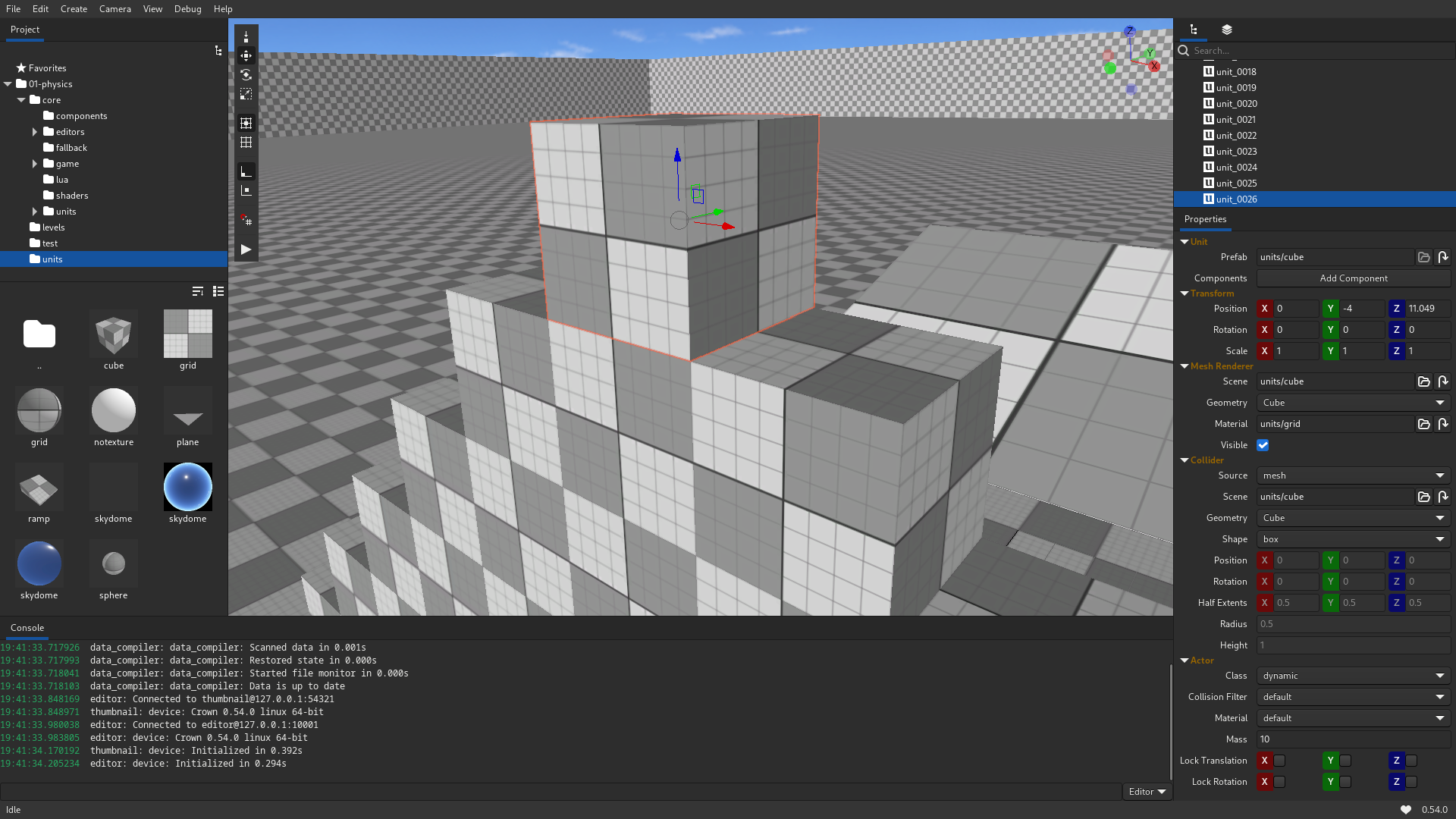Introduction¶
What is it?¶
Crown is a complete and cross-platform game engine designed for flexibility, performance, and fast-iterations.
It is not limited to a specific game type or genre; rather, it provides a set of versatile primitives and tools that can be used to create a broad range of both 3D and 2D games.

License¶
The games you create with Crown is your sole property. All the data (models, textures, levels etc.) and code you produce (including data and code that Crown itself outputs) is free for you to use as you wish. See License for an exhaustive list of the licenses involved.
Supported platforms¶
- Runtime
Android 7.0+ (ARMv7-a, ARMv8-a)
HTML5 (Wasm/Emscripten)
Ubuntu 20.04+ (x86_64)
Windows 7+ (x86_64)
- Editor
Ubuntu 20.04+ (or any 64-bit Linux with GTK+ >= 3.24)
Windows 7+
Design Principles¶
Crown is loosely inspired by the Bitsquid engine and shares with it many of its design principles:
- Data-driven
All aspects of the game are defined via text-based configuration files, which are compiled into native, efficient, platform-specific BLOBs before shipping. These files are human-readable, making them easy to inspect and compatible with traditional VCS and regular text-based utilities.
- Data-oriented
Data in memory is organized to achieve the maximum performance possible on every supported platform.
- Hot-reload everything
Every game asset is reloadable at run-time, including code.
- Multi-process Editor/Runtime architecture
The Editor and the Runtime live in separate processes. The Editor helds all the important data: if the Runtime crashes you can restart it without losing any work.
- Lightweight Codebase and Runtime
The Runtime (plus tools) consist of fewer than 70K lines of code. Written in straightforward ‘C-style’ C++, it is easily understood and extensible by anyone.
Features¶
- Cross-platform Editor
DCC data importers for models, textures, sounds etc.
Scene Editor with place/move/rotate/scale controls, snapping, selection etc.
Deployer for Android, HTML5 and desktop platforms.
Project Browser with thumbnails, global searching and multiple view modes.
Scene Tree and object Inspector.
Console with Lua REPL.
- Graphics
High-level 3D & 2D objects (meshes, cameras, lights and sprites).
Physically-based rendering pipeline.
Cross-platform GLSL-like shader programming language.
3D skeletal animation.
Animation state machine with events, variables and blending with simple expressions evaluator.
Immediate-mode GUI API with customizable materials.
TrueType text rendering via texture atlas.
Flipbook sprite animation.
FBX and custom mesh formats.
DDS, EXR, JPG, KTX, PNG, PVR and TGA texture formats.
D3D11, GL 3.2 and GLES 2.0 render backends.
- Physics
Static, dynamic and keyframed rigid bodies with multiple colliders.
Dedicated Mover object for controlling characters.
Collision begin/stay/end events.
Triggers with enter/leave events.
Spatial queries: ray-, sphere- and box-casts.
Joints (fixed, spring and hinge).
- Scripting
Integrated Lua runtime can be used to control every aspect of the game.
On supported platforms, LuaJIT is used for even higher performances.
Integrated REPL to quickly test and experiment while the game is running.
Live reloading of gameplay code without needing to restart the game.
- Debugging
Integrated profiler and data plotter graph.
C++ and Lua callstack generation.
- Input
Unified interface for mice, keyboards, joypads and touchpads.
Access to sub-frame input events list.
Simplified polling interface for rapid prototyping.
- Audio
3D audio sources with position and range-based attenuation.
Sound groups for bulk volume adjustments.
Audio streaming.
Formats: WAV and OGG.